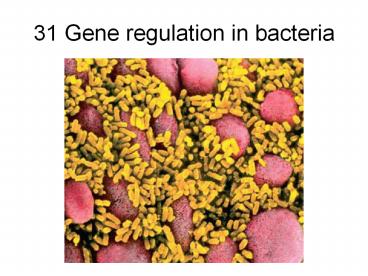31 Gene regulation in bacteria - PowerPoint PPT Presentation
Title:
31 Gene regulation in bacteria
Description:
Cells adjust to their environment by turning genes on and off. The operon concept ... Transposable element is cut out by transposase and inserts in another location. ... – PowerPoint PPT presentation
Number of Views:140
Avg rating:3.0/5.0
Title: 31 Gene regulation in bacteria
1
31 Gene regulation in bacteria
2
Lecture Outline 11/18/05
- Finish up from last time
- Transposable elements (jumping genes)
- Gene Regulation in Bacteria
- Transcriptional control
- Cells adjust to their environment by turning
genes on and off - The operon concept
- Repressors, Inducers, Operators, Promoters
- Repressible operons (e.g. trp)
- Inducible operons (e.g. lac)
3
Transposable elements
- Normal and ubiquitous
- Prokaryotes-
- Genes transpose to/from cells chromosome,
plasmid, or a phage chromosome. - Eukaryotes-
- Genes transpose to/from same or a different
chromosome. - Cause genetic changes
- Chromosome breaks
- Duplications
- Knock-out genes
4
Ill talk about 2 kinds
- Insertion sequences
- Ac/Ds elements in corn
- A third major class Retrotransposons
- Uses RNA intermediate and reverse transcriptase
- Most Important class in mammalian genomes
5
Insertion sequence (IS) elements
- Simplest type of transposable element
- Found in bacterial chromosomes and plasmids.
- Encode only genes for mobilization and insertion.
Inverted terminal repeats
6
Integration of an Insertion Element
IS element carries transposase gene
Transposase recognizes terminal repeats
Dont worry about the details, just the concept
Staggered cut at target site
Insert IS element
Fill in the gaps
7
Transposons
- Have additional genes, such as those for
antibiotic resistance - (examples Tn3 (ampicillin), Tn10 (tetracycline)
Transposon
Antibioticresistance gene
Insertion sequence
Insertion sequence
5? 3?
5? 3?
Inverted repeats
Transposase gene
Figure 18.19b
8
Barbara McClintocks discovery of transposons in
corn
- Kernel color alleles/traits were unstable.
- McClintock concluded transposon called Ds
inserted into the C gene for colored kernels
Nobel prize, 1983
9
Transposon effects on corn kernel color.
Ac can make transposase Ds can move, but lacks
enzyme
Two transposable elements in different sites
Normal gene for purple kernels
Ac activates Ds
Ds element inserts into color gene and
inactivates it
10
One method for Conservative Transposition
Cut and Paste Transposable element is cut out
by transposase and inserts in another location.
No increase in the number of transposable
elements- just a change in position
From Griffiths, Intro to Genetic Analysis
11
One method for replicative transposition
From Griffiths, Intro to Genetic Analysis
12
Gene regulation in bacteria
E.coli bacteria eat whatever we eat!
But ALL organisms must adjust to changes in their
environment and all have evolved numerous control
mechanisms.
13
Regulation of metabolism occurs at two levels
- Adjusting the activity of metabolic enzymes
already present - Regulating the genes encoding the metabolic
enzymes
14
Types of Regulated Genes
- Constitutive genes are always expressed
- Tend to be vital for basic cell functions (often
called housekeeping genes) - Inducible genes are normally off, but can be
turned on when substrate is present - Common for catabolic enzymes (i.e. for the
utilization of particular resources) - Repressible genes are normally on, but can be
turned off when the end product is abundant - Common for anabolic enzymes
15
In bacteria, genes are often clustered into
operons
- Operons have
- Several genes for metabolic enzymes
- One promoter
- An operator, or control site
- (on-off switch)
- A separate gene that makes a repressor or
activator protein that binds to the operator
R
O
1
2
3
P
P
16
The trp Operon
5 genes E, D, C, B, A
Same order as enzymes for trp synthesis
17
More Terminology
- Repressors and Activators are proteins that bind
to DNA and control transcription. - Co-repressors and Inducers small effector
molecules that bind to repressors or activators
18
The trp operon regulated synthesis of
repressible enzymes
Regulatory gene
Genes of operon
trpD
trpC
trpB
trpR
trpE
trpA
DNA
Operator
mRNA
3?
5?
mRNA
5?
C
E
D
B
A
Protein
Figure 18.21a
Tryptophan absent -gt repressor inactive -gt operon
on
19
Active repressor can bind to operator and block
transcription
DNA
No RNA made
mRNA
Protein
Active repressor
Tryptophan (corepressor)
Tryptophan present -gt repressor active -gt operon
off.
Figure 18.21b
20
Tryptophan changes the shape of the repressor
protein so it can bind DNA
21
- The lac operon regulated synthesis of inducible
enzymes
22
(No Transcript)
23
(No Transcript)
24
Positive Gene Regulation
- Both the trp and lac operons involve negative
control of genes - because the operons are switched off by the
active form of the repressor protein - Some operons are also subject to positive control
- Via a stimulatory activator protein, such as
catabolite activator protein (CAP)
25
Positive Gene Regulation- CAP
- In E. coli, when glucose is always the preferred
food source - When glucose is scarce, the lac operon is
activated by the binding of the catabolite
activator protein (CAP)
26
- When glucose is abundant,
- CAP detaches from the lac operon, which prevents
RNA polymerase from binding to the promoter































